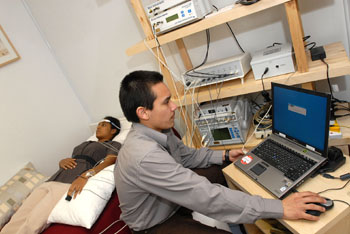Medical Physics launched at Lancaster University

A new Medical Physics Lab at Lancaster University will help researchers explore the relationships between brain, heart and breathing – shedding new light on how they interact.
The lab has equipment which monitors and records brain, heart and respiratory signals from volunteers who are hooked up in the specially designed pod which filters out electrical ‘noise’ from the atmosphere.
It was launched as part of Medical Physics at Lancaster, on the 11 May 2007 at an event attended by scientists and the volunteers who have been ‘measured’ using the equipment .
The important data which is being collected may be used to improve medical care of patients with heart and other problems.
Medical Physics at Lancaster is already being used in an international project which has the potential unravel the mysteries of anaesthesia.
Anaesthesiology is a subtle and imperfect science that is not currently well understood. Without it most modern surgical procedures would be impossible but the mechanisms causing loss of consciousness are not clear. This can result in complications such as a patient regaining consciousness during an operation or, in the most extreme circumstances, death.
The Lancaster University-led BRACCIA project is exploring ways in which the brain’s electrical activity varies with the depth of anaesthesia and how waves present in these electrical signals interact with heart and respiration rhythms.
Changes in these three signals, and how they interact with one another, can be used to provide a crucial insight into the changes taking place in the human body during anaesthesia.
The ultimate aim of the project - which is backed by a €1.42 million grant from the European Commission – is to develop the understanding needed to create a new, effective anaesthetic monitor which could be used in operating theatres to keep track of a patient’s level of consciousness.
More than 140 patients undergoing surgery will be monitored at both the Ulleval Hospital in Oslo and at the Royal Lancaster Infirmary, Lancaster. The volunteers will have their brain, heart and respiratory signals monitored and recorded before during and after anaesthesia. This should give researchers important information about the progression from unconsciousness to consciousness.
Project scientific coordinator Dr Aneta Stefanovska, from Lancaster University’s Physics Department, said: “Medical Physics uses nonlinear dynamics to deepen our understanding of the body and how its systems interact. This new knowledge has a very clear application and we hope it could eventually be used to develop a failsafe system for measuring anaesthesia levels in patients. It would also enable us to explore the effects of anaesthetic drugs on consciousness.”